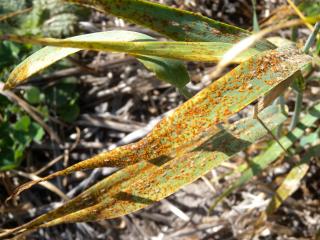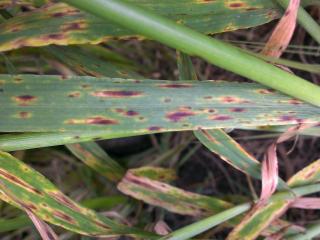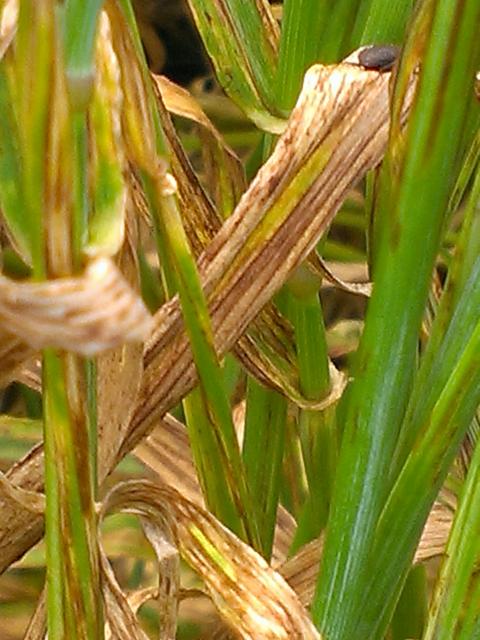Barley leaf rust
Barley leaf rust (Puccinia hordei) has developed into a recurring threat since the occurrence of pathotypes in 1997 that infect Franklin and Gairdner. It is an aggressive and difficult foliar disease to control and can be a recurring problem in crops in the southern high rainfall zones. Early disease risk is high when there is volunteer barley (green bridge) harbouring this rust over summer. Barley leaf rust frequently causes yield and quality losses. In seven field experiments from 2002-2006, application of fungicide to infected plants resulted in yield improvement ranging from 3-145% (mean yield improvement of about 33%) depending on the time of disease onset, fungicide product, rate and time of application. The yield benefits were accompanied by large reductions in screenings and improved grain colour. Details and more photos of the symptoms of barley leaf rust are available on the MyCrop page.
Control
- Sowing resistant varieties is the most economical way to control the disease. Most of the current malting varieties are susceptible (S) except for Granger (R/MR) but there are some resistant (R) feed varieties such as Oxford. The detection of new leaf rust pathotype 5457P in 2013 on the south coast indicates most the barley varieties with Rph3 gene are now vulnerable and now should be treated as susceptible. These varieties such as Bass need to be managed with fungicides in the presence of the disease. Experiments conducted in to south coast during 2014/15 indicate that varieties such as Flinders which possess slow rusting genes also known as adult plant resistant genes (APR), such as Rph20, are moderately resistant to the new leaf rust pathotype. See the Crop Sowing Guide for disease resistance profile.
- Minimise green bridge risk by grazing or applying herbicide to remove any volunteer barley which emerges following summer or autumn rains.
- Many of the seed dressing or in-furrow fungicides registered for control of other barley diseases have been shown to be effective in preventing early leaf rust infection under experimental conditions, but they are not currently registered for this use.
- Apply fungicide spray if disease threatens well grown crops. Where an early outbreak of leaf rust in barley occurs, the initial spray should be applied at the onset of the disease and followed by a second application three to four weeks later. Early foliar fungicide sprays are more effective than seed dressing or in-furrow fungicide application for control of early infections of barley leaf rust.
More information can be found on the implications of the latest new barley leaf rust pathotype found in WA.
Spot-type net blotch
Spot-type net blotch (Pyrenophora teres f.sp. maculata) occurs state-wide but is most damaging in south coastal and neighbouring medium to high rainfall regions where it can have severe yield and quality effects. This disease is stubble-borne so is more severe where barley is grown year after year in the same paddock. In high disease situations in the southern high rainfall region, more than 35% yield loss has been observed. In addition, current research indicates that every 10% increase in leaf area lost to this disease on the top three leaves accounts for 0.4t/ha yield loss. Outbreaks can also occur in central and northern agricultural areas. Details and more photos of the symptoms of spot-type are available on the MyCrop page.
Control
- Avoid sowing susceptible (S) and very susceptible (VS) varieties, particularly in high production situations.
- A one-year break between barley crops in a paddock will markedly reduce the potential for serious disease. If highly effective stubble retention systems are in use, a two-year break may be required.
- The recently released seed dressing fungicide Systiva® (fluxapyroxad) is registered for the control of both STNB and NTNB. It provides systemic protection and may reduce the need for a first foliar fungicide at tillering - stem extension.
- Applying a fungicide spray is necessary in medium to high rainfall regions where disease threatens crops with high yield and quality expectations. The choice of a single-spray or two-spray strategy depends on the environment in which the crop is growing.
- In high rainfall environments it may be necessary to apply two sprays, such as at early stem elongation stage with a follow-up spray three to four weeks later.
- In medium rainfall regions, consider one well timed spray between late stem elongation and early flag leaf emergence (Z33 - 39) to protect leaf two (flag-1). Under high disease pressure, best results may be obtained by using the maximum recommended rates.
Further information is available on Managing net-type and spot-type net blotch in barley and Managing spot-type net blotch in continuous barley.
Net-type net blotch
Net-type net blotch (Pyrenophora teres f. teres) disease occurs throughout the barley growing areas of Western Australia including the medium and low rainfall areas. This disease can be both stubble- and seed-borne. Infection and spread of this disease is favoured by wet conditions and it is most evident following periods of rainfall. It will cause the greatest yield loss in paddocks that are re-sown to barley without a break-crop. Details and more photos of the symptoms of net-type net blotch are available on the MyCrop page.
Control
- Effective control practices for this disease are the same as those described above for spot-type net blotch, along with the additional strategy below.
- If seed-borne net-type net blotch is suspected, seed can be sent to DAFWA's Diagnostic Laboratory Services for seed for diagnosis prior to seeding. If seed is infected, treating it with a fungicide registered for suppression of seed-borne net-type net blotch can reduce seed to seedling transmission. However, this method of spread is not considered important in the overall level of infection by this disease in barley crops in Western Australia. See the Seed dressing and in-furrow fungicides for cereals page for further information.
Further information is available on Managing net-type and spot-type net blotch in barley.



